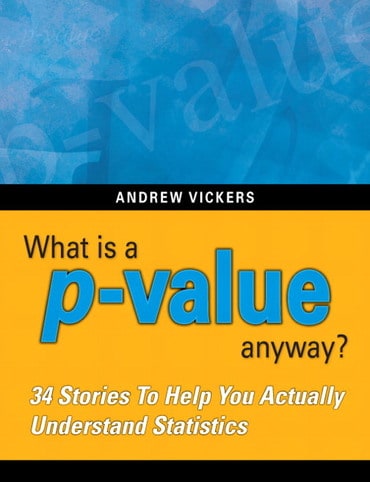
What is a p-value anyway? 34 Stories to Help You Actually Understand Statistics, 1st edition
Published by Pearson (November 18, 2009) © 2010
Andrew J. Vickers
Switch content of the page by the Role togglethe content would be changed according to the role
Title overview
What is a p-value Anyway? offers a fun introduction to the fundamental principles of statistics, presenting the essential concepts in thirty-four brief, enjoyable stories. Drawing on his experience as a medical researcher, Vickers blends insightful explanations and humor, with minimal math, to help readers understand and interpret the statistics they read every day.
What is a p-value Anyway? is the perfect complement to any introductory statistics textbook and will succeed in demonstrating the everyday importance of statistics to your class.
- Short, enjoyable stories help readers understand the fundamental concepts of statistics without getting slowed down by formulas.
- Chapters 1—12 cover the basics, such as averages, variation, distributions, and confidence intervals.
- Chapters 13—21 cover hypothesis testing, p-values, and regression.
- Chapters 22—34 cover common statistical errors and misconceptions.
- Discussion questions stimulate conversation and help readers think about statistics.
Table of contents
-
Introduction
-
0. How to read this book
-
1. I tell a friend that my job is more fun than you'd think: What is statistics?
-
Describing data
-
2. So Bill Gates walks into a diner: on means and medians
-
3. Bill Gates goes back to the diner: standard deviation and interquartile range
-
4. A skewed shot, a biased referee
-
5. You can't have 2.6 children: on different types of data
-
6. Why your high school math teacher was right: how to draw a graph
-
Data distributions
-
7. Chutes-and-ladders and serum hemoglobin levels: thoughts on the normal distribution
-
8. If the normal distribution is so normal, how come my data never are?
-
9. But I like that sweater: what amount of fit is a "good enough" fit?
-
Variation of study results: confidence intervals
-
10. Long hair: a standard error of the older male
-
11. How to avoid a rainy wedding: variation and confidence
-
12. Statistical ties, and why you shouldn't wear one: more on confidence intervals
-
Hypothesis testing
-
13. Choosing a route to cycle home: what p-values do for us
-
14. A statistical theory of how to get a five-year old boy to brush his teeth: defining the p-value
-
15. Michael Jordan won't accept the null hypothesis: how to interpret high p-values
-
16. The difference between sports and business: thoughts on the t test and the Wilcoxon test
-
17. Meeting up with friends: on sample size, precision and statistical power
-
Regression and decision making
-
18. When to visit Chicago: about linear and logistic regression
-
19. My assistant turns up for work with shorter hair: about regression and confounding
-
20. I ignore my child's cough, my wife panics: about specificity and sensitivity
-
21. Avoid the sales: statistics to help make decisions
-
Some common statistical errors, and what they teach us
-
22. One better than Tommy John: four statistical errors that are totally trivial, but which matter a great deal
-
23. Weed control for p-values: a single scientific question should be addressed by a single statistical test
-
24. How to shoot a TV episode: avoiding statistical analyses that don't provid
Author bios
Andrew Vickers, PhD, is an Associate Attending Research Methodologist in the Department of Epidemiology and Biostatistics at Memorial Sloan-Kettering Cancer Center in New York. He is active in a variety of fields of cancer research, and also conducts original research in statistical methods, particularly with respect to the evaluation of prediction models. Dr. Vickers has been course leader for the biostatistics course at the Memorial Sloan-Kettering Cancer Center since 2001, and has taught biostatistics to medical students at Cornell Medical School since 2000. Dr. Vickers received a First Class BA in History and Philosophy of Science from the University of Cambridge and a PhD in Clinical Medicine from the University of Oxford.
